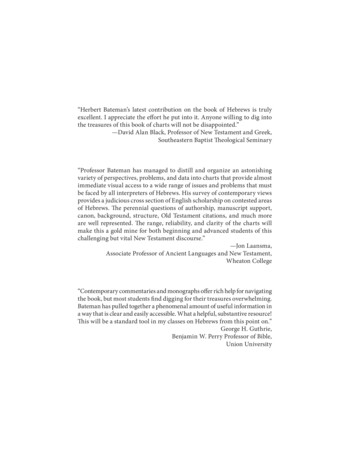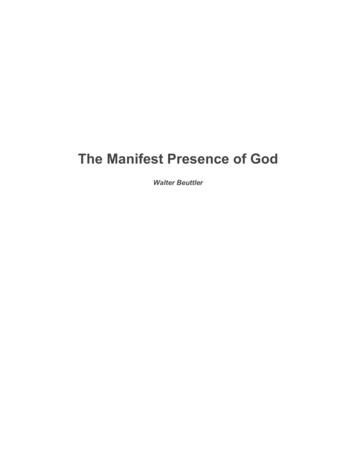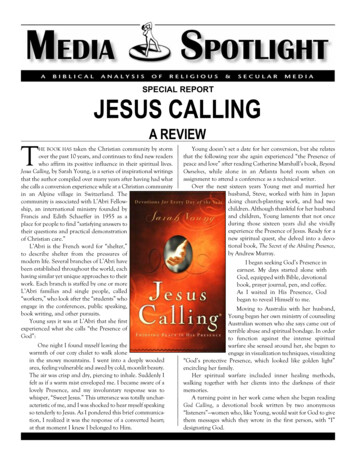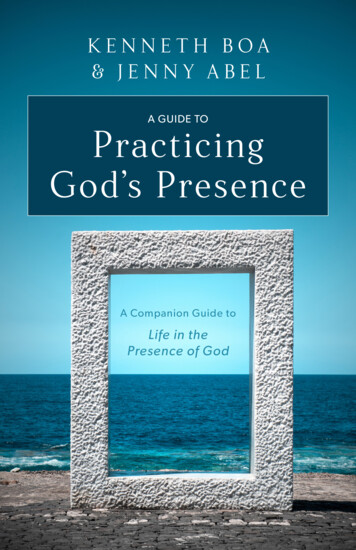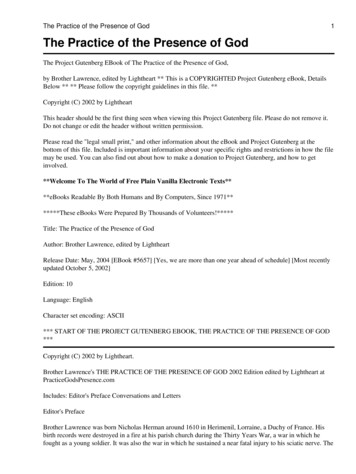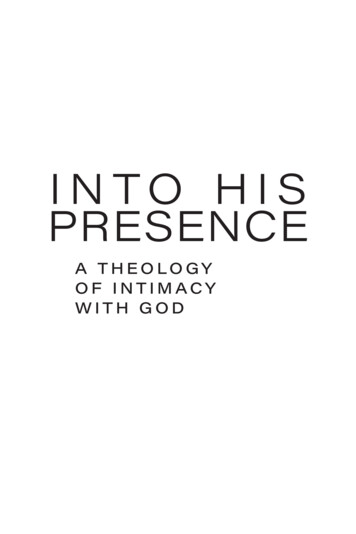
Transcription
INTO HISPRESENCEA THEOLOGYOF INTIMACYWITH GOD
INTO HISPRESENCEA THEOLOGYOF INTIMACYWITH GODTim L. AndersonKregelAcademic
Into His Presence: A Theology of Intimacy with God 2019 by Tim L. AndersonPublished by Kregel Academic, an imprint of Kregel Publications, 2450 Oak Industrial Dr.NE, Grand Rapids, MI 49505-6020.All rights reserved. No part of this book may be reproduced, stored in a retrieval system, ortransmitted in any form or by any means—electronic, mechanical, photocopy, recording,or otherwise—without written permission of the publisher, except for brief quotations inprinted reviews.All Scripture quotations, unless otherwise indicated, are from the New American StandardBible . Copyright 1960, 1962, 1963, 1968, 1971, 1972, 1973, 1975, 1977 by The LockmanFoundation. Used by permission. www.Lockman.org.Scripture quotations where indicated are from The Message. Copyright 1993, 1994, 1995,1996, 2000, 2001, 2002. Used by permission of NavPress Publishing Group.Scripture quotations where indicated are from The New Testament in Modern Englishby J. B. Phillips copyright 1960, 1972 J. B. Phillips. Administered by The Archbishops’Council of the Church of England. Used by permission.Scripture quotations where indicated are from The Living Bible copyright 1971 byTyndale House Foundation. Used by permission of Tyndale House Publishers Inc., CarolStream, Illinois 60188. All rights reserved.Scripture quotations where indicated are from The Orthodox Jewish Bible fourth edition,OJB. Copyright 2002, 2003, 2008, 2010, 2011 by Artists for Israel International. All rightsreserved.Scripture quotations marked NEB are from the New English Bible, copyright CambridgeUniversity Press and Oxford University Press 1961, 1970. All rights reserved.Scripture quotations marked NKJV are from the New King James Version . Copyright 1982 by Thomas Nelson. Used by permission. All rights reserved.Scripture quotations marked ESV are from The Holy Bible, English Standard Version.ESV Text Edition: 2016. Copyright 2001 by Crossway Bibles, a publishing ministry ofGood News Publishers.Scripture quotations marked NIV are from the Holy Bible, New International Version ,NIV Copyright 1973, 1978, 1984, 2011 by Biblica, Inc. Used by permission. All rightsreserved worldwide.The Greek font GraecaU and the Hebrew font New JerusalemU are both available fromwww.linguistsoftware.com/lgku.htm, 1-425-775-1130.ISBN 978–0–8254–4467–8Printed in the United States of America19 20 21 22 23 / 5 4 3 2 1
To My Wife BarbaraGod’s gracious provisionof the best partner in this lifeI could ever have.
CONTENTSAcknowledgements 9Introduction 11Chapter 1: Defining Intimacy with God 23Chapter 2: The Place of Intimacy with God in Philosophy and Theology 43Chapter 3: Understanding the Fall and Intimacy with God 67Chapter 4: Interpreting Biblical Symbols for God’s Communicationof Intimacy 89Chapter 5: Interpreting the Biblical Image of God Our Fatheras a Script of Intimacy for the Shamed 111Chapter 6: Interpreting Biblical Images of Marriage and Christ 141Chapter 7: Interpreting Intimacy with the Holy Spirit 179Chapter 8: Interpreting Suffering and Intimacy with God 207Chapter 9: Assessing Our Songs of Intimacy with God 231As We Conclude . . . 259Scripture Index 265Name / Author Index 275
ACKNOWLEDGEMENTSWhen it is claimed, “It takes a village to raise a child,” I would also add,“It takes a village to write and publish a book.” I have been blessed bythe Lord not only with His Word and guidance throughout this project, butHe has blessed me with many people whose help has been invaluable.Corban University has been the greenhouse for significant aspects ofthis book. I am so grateful for the sabbatical to write the proposal and thebulk of the manuscript. Dr. Greg Trull’s support is immeasurable. He originally suggested that I teach my Intimacy with God course, worked with myteaching schedule to make research easier, provided help in framing certainchapters, and also provided the ability to take time off from teaching for mysabbatical. Several of my Corban colleagues helped in many different ways.Dr. Gary Derickson put me in contact with Kregel, and has been very reassuring throughout. I cannot thank David Sanford enough for his unendingsupport, advice, and help with the book proposal. Dr. Ryan Stark sacrificiallyread a large portion of the original manuscript and helped me be a betterwriter. Any inadequacies in the book are solely mine. My dear colleagues Dr.Sam Baker, Dr. Leroy Goertzen, and Dr. Marty Trammell have been so helpful and encouraging in all the parts of the process. My students in my Intimacy with God classes helped me clarify the concept as well as its depth andbreadth.Dr. Erik Thoennes has been a dear friend and supporter for two decades.He encouraged me to find my voice as an author. His example has inspiredme along this journey.9
10 AcknowledgementsI’m so grateful to be on Kregel’s team of Herb Bateman, Dennis Hillman,Laura Bartlett, and Shawn Vander Lugt. They have made this book more thanI ever thought it could be.Finally, the continuous support, sacrifice, excitement, and encouragement of my wife Barbara, and each of my children, David, Jonathan, Emily,and Stephen, has been vital and precious to me.Thank you, Village.
INTRODUCTIONAS WE BEGIN . . .When I was a freshman in college, I made the decision to follow the Lordwholeheartedly. One of my initial desires was (and still is) to relate to Godas He has proscribed in the Bible. One Sunday I was listening to my pastorpreach, and I was struck to my spiritual core by a thought that had never evenremotely occurred to me in all my years of growing up in the church: “Whodo I pray to?” This was not a venture into other religions; rather, I was simplyasking, “Do I pray to the Father only? To the Son, Jesus Christ? To the HolySpirit? Am I slighting or disrespecting any one of Them when I am praying toone of the Others? Is it possible to pray to only one of Them?” In my growingfaith, I simply had a desire to pray right. This was accompanied by the realization that what I believed about intimacy with God had profound implications.That same year, a friend gave me his own personal copy of A. W. Tozer’sThe Pursuit of God. Tozer began to open my world to the understanding thatthe rightness of my relationship with God is to be combined with my closeness to Him. Specifically, Tozer makes this astounding assertion: “God willsthat we should push on into His Presence and live our whole lives there.”1 Likeentering into the biblical temple’s Holy of Holies, rightness is combined withcloseness. Maybe you can relate to that in your spiritual journey as well. Thereare times when I still feel like a freshman in my understanding and close1. A. W. Tozer, The Pursuit of God (Harrisburg, PA: Christian Publications, 1948), 36–37,italics his.11
12 Introductionness to God in Three Persons, Blessed Trinity. Furthermore, when discussingintimacy with God with my students, in small groups at church, at retreatsand conferences, and during counseling sessions, I have heard a variety ofperspectives—some cogent and some very peculiar, some derived from bitsand pieces of Scripture understood in isolation, some derived from sitcomsand Disney films. A study on what the Bible says about intimacy with God, tome, seems to be crucial for our day.WHAT THIS BOOK IS NOT ABOUTSo as we begin, it would be helpful to make clear what this book is notabout. This book will not be a narrative of someone’s personal experiencewith God, on his or her own journey from distance or loneliness to a feelingof closeness with Him, though I would validate many such narratives. Indeed,it would be tragic if, after reading this book, readers were not moved towardGod one iota. As Ron Brackin pointedly advises, “We can read a good spiritual book in search of information or in search of God. We will find only whatwe’re looking for.”2 Reading this book does not have to be one or the other,either. In fact, I hope it is both.This book will also not be a “how-to” devotional guide, providing ten stepsto a better intimacy with God, or some such formulation. At the same time,we are certainly examining the Bible’s theology on intimacy with God, and sowe should expect transparent principles to rise to the surface and function asassessment points for us to tell, for example, if we truly are any closer to Godtoday than yesterday or last year. Additionally, this book cannot hope to addressall of your favorite passages, or pursue every corollary theme related to intimacy with God in the Bible. I apologize straight away, but the basic topic athand is more than enough to keep me busy throughout. Keep in mind, too, thatwhat may seem to be a direct correlation or implication may not be addressedbecause I simply have not noticed it, or perhaps I chose other themes to developthat were, in my mind, more germane. In other words, there are undoubtedlymissed opportunities in my pursuit of the topic, but I hope that my fundamental aim has been achieved: to explain intimacy with God in a way that answersfundamental questions about who God is and how we are to relate to Him.Let me add at this point that this is not a book that claims to be written bysomeone who has all the answers, nor does the book want to sound preten2. Ron Brackin, “Reading Skills Quotes,” Goodreads, .
Introduction 13tious, and so if you take it that way, I am sorry—please allow me the chance toexplain, and then you can make a judgment.WHAT THIS BOOK IS ABOUTSo what is this book about? In short, this study will develop what the Biblesays about intimacy with God. However, before we get into specific definitionsand concepts, let me start by addressing its purposes. First, it is an affirmation.When Christians study the Scriptures, there will be a shared agreement overbasic and most important truths because of the promised Holy Spirit’s work(John 14:26; 1 Cor. 2:12; 1 Thess. 4:9; 1 John 2:26–27). Believers have alwayssought to draw near to their God. While sin separates, trust in the salvationGod provides by faith has been a rallying point throughout the ages. It isa glorious reality that Abraham, Moses, David, Daniel, the disciples, Paul,John, Peter, Antony, Augustine, Aquinas, John of the Cross, Teresa of Avila,Luther, Calvin, Owen, Edwards, Wesley, Parham, Nee, Tozer, Lewis, Merton,Nouwen, etc. have all drawn near to the God of their salvation. They all havesomething to teach us as well. The significance of recent classics should neverbe minimized. They are profoundly enriching works, yet they are a product oftheir time, culture, worldview, philosophy, theology, and human limitations.Their theological method is often less precise and more devotional in thrust.For example, Tozer’s The Pursuit of God is a classic text on intimacy withGod; and as I have already shared, I am indebted to him on a profound level.However, as important as this work is, it is broader than what I am attempting. Also, a more thorough biblical theology needs to be done to provide amore substantive grounding in scriptural data and specific biblical themes.J. Oswald Sanders’s Enjoying Intimacy with God is another classic book onthis topic.3 It includes concepts that I will also develop, and yet it includesbroader Christian life issues; again, the key difference is that his is more of adevotional, practical, how-to book, not a robust systematic/biblical theology.The other purpose of this book is to attempt an intervention of sorts. Byits very nature, an intervention into someone’s life, ideas, and experienceis emotional and challenging, and yet necessary and affirming. This book’sintercession will seek to address head-on the foundational assumptions andimprecise theologies of intimacy with God that appear to be addictive. Theseassumptions are quite evident in the sheer amount of books that have beenwritten with “intimacy with God” in the title in the last two decades. There are3. J. Oswald Sanders, Enjoying Intimacy with God (Grand Rapids: Discovery House, 2000).
14 Introductionthree categories of the types of works and issues: Catholic Mystical, Pentecostal Experiential, and Evangelical Devotional.Catholic MysticalContemporary Catholic mystical writers like Thomas Merton and ThomasKeating are part of a tradition that dates back to the early monastic movements.Their passion to mortify the sins of the flesh is commendable. Their spiritualself-discipline is in itself exemplary. Their desire to connect with God as a twoway experience is a crucial corrective to a one-way—we talk and He listens—approach. So I haltingly bring anything negative against these deeply sincerespiritual giants. However, one challenge for them is that they tend to followaspects of a tradition born out of a Neoplatonic view of reality and humanityfrom Augustine and St. John of the Cross.4 This simply means that the body andflesh are less valuable than the spiritual and rational. One problem with this isthat they can also drift toward an Eastern mysticism that tries to free the selffrom fleshly hindrances. While this may be commendable, such attitudes canfocus less on immersion in truth of what God has revealed in the Scriptures, andmore on escaping the confines of our earthly existence and emptying ourselvesof our rational humanity. Their goal is the achieving a union with God that hasus being absorbed into Him5—that is, His spirit, will, and essence—rather thanhaving a relational unity that preserves our personal human identity.64. Pearcey rightly notes, “Partly because Augustine was such a towering figure in church history,a kind of Christianized Platonism remained the lingua franca among theologians all the waythrough the Middle Ages.” Nancy Pearcey, Total Truth: Liberating Christianity from Its CulturalCaptivity, Study Guide Edition (Wheaton, IL: Crossway, 2005), Loc. 1740; José C. Nieto,Mystic, Rebel, Saint: A Study of St. John of the Cross (Genève: Librarie Droz, 1979), 126.5. One type of example of this union can be found in Thomas Merton, New Seeds ofContemplation, introduction by Sue Monk Kidd, Kindle ed. (New York: New Directions,1961, 2007), loc. 257.Contemplation is also the response to a call: a call from Him Who has no voice, andyet Who speaks in everything that is, and Who, most of all, speaks in the depths ofour own being: for we ourselves are words of His. But we are words that are meantto respond to Him, to answer Him, to echo Him, and even in some way containHim and signify Him. Contemplation is this echo. It is a deep resonance in theinmost center of our spirit in which our very life loses its separate voice and resounds with the majesty and the mercy of the Hidden and Living One. He answersHimself in us and this answer is divine life, divine creativity, making all things new.We ourselves become His echo and His answer. It is as if in creating us God asked aquestion, and in awakening us to contemplation He answered the question, so thatthe contemplative is at the same time, question and the answer.6. See Thomas Keating’s book, Intimacy with God: An Introduction to Centering Prayer(New York: Crossroad, 2009), for a modern mystical Catholic perspective. Alex Aronis’sDeveloping Intimacy with God: An Eight-Week Prayer Guide Based on Ignatius’ “Spiritual
Introduction 15Pentecostal ExperientialThe Pentecostal experience writers find their roots in the MethodistHoliness movements of the late nineteenth-century America. Their practicaland transformative Christianity has rightly found fertile ground around theworld. The resurgence of experiencing the Holy Spirit’s ministry has been anecessary intervention into the church. The expectation of experiencing thetrue and living God is important for any age of the church. However, thisexperiential emphasis, coupled with an unassailable American individualismand existentialism, has resulted in some having the mindset that everythingintimate and miraculous with God that believers experience in the Bible canand should be the norm for all Christians today.7 Thus experiential claims,no matter how bizarre, cannot be challenged. Claims of intimacy with Godthrough visions and experiences of Jesus are becoming more common. DavidTaylor, in his Face-to-face Appearances from Jesus: The Ultimate Intimacy,assumes that since Jesus has supposedly appeared to him on more than oneoccasion, seeing Him “face-to-face” is normative for believers today. In addition, these visions bring intimacy, prosperity, and a clear destiny for one’s life.8Evangelical DevotionalThe evangelical devotional writers often find their foundations in thePuritans, the Great Awakening, the fundamentalist/modernist controversies,and the broadening of the evangelical movement. Like most evangelicals,the personal conversion experience is necessary, but must be followed with adiscipleship based upon studying the Bible’s teachings on the broader issuesExercises” (Bloomington, IN: Author House, 2003) is an interesting Catholic approachbased upon an early church father, though this is not rooted in a biblical theology but inelements of a Neoplatonic philosophy.7. Phillip H. Wiebe, “The Pentecostal Initial Evidence Doctrine,” Journal of the EvangelicalTheological Society 24, no. 7 (1984): 465–72; Beni Johnson, Sue Ahn, Ann Stock, DeAnneClark, Heidi Baker, Sheri Hess, Winnie Banov, and Nina Myers, Beautiful One: A Walkin Deeper Intimacy with the One Who Created Us, ed. Shae Cooke (Shippensburg, PA:Destiny Image, 2010).8. David Taylor, Face-to-face Appearances from Jesus: The Ultimate Intimacy (Shippensburg,PA: Destiny Image, 2009). We will later examine the claims of Matthew Robert Payne,in his Finding Intimacy with Jesus Made Simple (Litchfield, IL: Revival Waves of GloryBooks & Publishing, 2016). In Experience the Power of God’s Presence: A Call to Intimacywith God, Volume 1 (Royal Center, IN: Exson Publishing, 2012), Harry Muyenza focuseson defining worship and experiencing Pentecostal phenomena for intimacy with God.Joyce Meyer, in her Knowing God Intimately: Being as Close to Him as You Want to Be(New York: FaithWords, 2008), uses “Scripture and powerful real life examples” in herPentecostal approach, focusing mainly on the baptism of the Holy Spirit and gifts.
16 Introductionof the Christian life. Thus intimacy with God is a topic associated with learning to practice the Christian life. The clearest evidence of this is by doingone’s devotions. Their literature tends to focus on an American pragmatismof how to achieve intimacy with God.9 Others incorporate psychology intotheir approach to a close relationship with God. This can be very useful, andyet they do not provide substantial theological grounding for its elements.10Planning for PrecisionSo what’s my plan? One cannot pursue an affirmation and an interventionwithout a plan. As a minimum, we need to work toward a precise definitionof intimacy with God. This is especially important when it appears that ourculture faces the temptation to reduce intimacy with God to an experientialnarrative and to spiritual how-to lists. Thus, precise definitions seem to be anafterthought at best. J. Gresham Machen in What Is Faith? pointed out liberalism’s aversion to precision. He noted:9. Steve Korch, My Soul Thirsts: An Invitation to Intimacy with God (King of Prussia,PA: Judson, 2000), has good elements in its approach to intimacy with God, but ismore of a how-to book for a more popular audience. It is also more conceptual atpoints than biblical (for example, see sections on joy [for the “humor-impaired”],prayer/spiritual power [“overcoming life’s obstacles”], knowing the Bible [“hearingGod’s voice with your whole being”], and authentic passion for God [“dancing inthe Arms of God”]), and much broader in scope than the present volume. MalcolmMacdonald, Set Me on Fire: Being Filled with the Presence of God (Venice, CA: Monarch,2015), is classified under Christian Living on Amazon, and under Christian Life andDevotionals on Kregel onals/setme-on-fire). Randy Madison’s Pursuing Intimacy with God: Life’s #1 Priority (Las Vegas:Next Century Publishing, 2010) is a book based in his sermon series on this topic. Itis therefore limited in scope to certain passages and themes, and lacks theologicaldepth, clarity, and precision. Christian Paul Osburn’s The Key That Unlocks the Doorto Intimacy with God (Kindle ed., Amazon Digital Services, 2014) is a “how-to” that ismore of a basic theology booklet about being able to be right with God/justification.Dr. Benjamin Sawatsky’s Intimacy with God: Drawing Ever Closer to the Almighty(Colorado Springs: Book Villages, 2011) develops theological themes in practicalways (i.e., “Intimacy with God and the Holy Spirit”), yet it is broader than intimacywith God as it ventures into other areas of God’s role in the Christian life (e.g., “TheHoly Spirit as My Resident Rabbi”). Eddie Snipes’s Simple Faith: How Every PersonCan Experience Intimacy with God (Carrollton, GA: GES Book Publishing, 2011) is abasic introduction to Christian faith that appears to be intended for newer believersand lacks theological development.10. Dr. Anthony J. Fischetto, Transformed: Intimacy with God (Reading, PA: AlphaOmega Counseling Center, 2000). This book, written by a psychologist, centerson avoiding the stress of life through Christian meditation and psychobiology. Dr.Norm Wakefield’s Living in God’s Presence: Pursuing Intimacy with Our HeavenlyFather (Loveland, CO: Walking Carnival, 2013) is not theological but psychologicaland devotional.
Introduction 17This temper of mind is hostile to precise definitions. Indeed nothing makesa man more unpopular in the controversies of the present day than an insistence upon definition of terms. . . . Men discourse very eloquently todayupon such subjects as God, religion, Christianity, atonement, redemption,faith; but are greatly incensed when they are asked to tell in simple languagewhat they mean by these terms.11First, I would add that for many in our era it isn’t simply an aversion to precisedefinitions, but an inability to see the need for them on a substantive level. If intimacy with God is personal, then it is subjective and relative. To claim a precisedefinition could alienate people, invalidate their experiences, and thus comeacross as imperialistic and hostile. Second, men and women are speaking veryeloquently on the subject of intimacy with God but we find that there is a hesitancy to claim some definitions and approaches as being out of bounds. Thisreluctance is motivated in part by viewing intimacy with God as a means to spiritual and emotional health. And there are many paths and practical ways to thatend for the individual. Yet, this kind of posture is precisely why we need to havea robust and clear theological development of the concept of intimacy with Godfrom the source of truth God has revealed, in the Scriptures to His creations.We also face the temptation to absolutize intimacy with God. The Achilles heel of any worldview or theological position is when it either makes toomuch of its theological importance or reduces its complexities to somethingtoo simple.12 For example, I have had students absolutize God’s sovereigntyeven in His gift of free will, to the point that they claim that God is the ultimate author of evil. In the past some hyper-Calvinists have absolutized God’ssovereign choice in election to the point that they have denied the need forevangelism. Similarly, some Baptists have absolutized religious liberty to thepoint that they have allowed in their churches and seminaries the denial ofcertain fundamentals of historic orthodox Christianity. Some of my students,because of cultural and theological forces, have absolutized God’s love to theextent that when I ask them what the Bible is all about, they say almost without thinking, “It’s God’s love letter to mankind.” All I have to do is ask themhow they would fit the Bible’s kingdom theme and the judgments of Revelation into that and their foreheads begin to wrinkle. Intimacy with God is not11. J. Gresham Machen, What Is Faith? (New York: Macmillian, 1925), 13–14.12. Steve Wilkins and Mark Sanford, Hidden Worldviews: Eight Stories That Shape Our Lives(Downers Grove, IL: IVP, 2009).
18 Introductionthe theme of the Bible. However, it is a significant theme and, as we will see, itdoes overlap with other important scriptural themes and foundations.Some define intimacy with God by absolutizing one Bible verse. Forexample, Fischetto bases his approach to intimacy with God around Psalm46:10, “Be still and know that I am God.” To him, this passage teaches us “howto be still and know God personally, passionately, and powerfully.” Thus spiritual and physical meditation is absolutized as the key to intimacy with God.13I am not dismissing the fact that there are key passages that function as partsof the foundation to key biblical concepts (Eph. 2:11–22; Heb. 4:16; 10:19–22; James 4:8; etc.). Absolutizing, however, funnels all other experiences andbiblical data through one main and defining passage. It is as if the gospel itselfcan be fully explained by writing John 3:5 on a sign at an NFL football gamefor all to see. The gospel is more than the phrase “being born again.” Intimacywith God is more than “Be still and know that I am God.”AGAIN . . . WHAT THIS BOOK IS ABOUTI have developed this book as a biblical and theological affirmation ofthe profound teaching on intimacy with God in the Scriptures. These sacredWritings not only describe coming into authentic and safe contact with thehigh and holy Creator and Redeemer of the human race, but they invite us tobe a part of a relationship that is nothing short of epic. Think of it! The movement of God toward the beings He has made in His image is an epic dramathat is as real as any national or personal history. In order to capture as muchof the teachings of Scripture as possible, I have framed this book primarilyaround how biblical and systematic theology work. In other words, a theologyof intimacy with God should address many of the structural issues importantto theology, its categories and terms, as such a theology should go where thebiblical data leads. Moreover, it must address some current issues and trends.Thus I hope that this theology will serve as an example and model for doingtheology on other relevant topics.Chapter 1 introduces the concept of intimacy with God. Much like thebeginning of a college course, this is where the instructor provides focusto the students as to what they will be studying all semester long. What isgeology, educational philosophy, Christology, etc.? Here I provide a definition of intimacy with God as the movement of God and Christians towarda place of true knowledge and close contact. Imbedded in this definition are13. Fischetto, Transformed: Intimacy with God.
Introduction 19the four key scriptural elements of intimacy with God, which are the yarnthat knits the whole intimate sweater together. The sweater metaphor, incidentally, is optional.Chapter 2 focuses on what theologians call “theological prolegomena,”that is, the preface to doing theology. When Tolkien wrote the preface to theLord of the Rings, he simply stated that it is “largely concerned with hobbits.”14J. I. Packer positions his classic work Knowing God on His attributes as a bookfor travelers on a journey, rather than simply for those who watch the journeyand ask questions and make observations from a balcony above.15 With thesame intent, I will try to show where intimacy with God fits into the broaderconcepts of philosophy and theology in order to show where it is, where weare, and where we should go. Therefore, at the outset, we must recognize Godas the source of our very existence, consciousness and delights, the indispensible human elements for an intimate relationship with Him. Our verypersonal expressible and inexpressible knowledge of Him is also a graciousdivine gift and responsibility for us. This focuses our study and pursuit uponGod’s self-revelation in the Bible, and thus we form our theology primarilyfrom it. That theology reveals our God as the immanent and yet transcendent One who is omnipresent, omniscient, and condescending. His natureand attributes will help us assess other examples of approaches to intimacywith God such as those situated within the three camps listed above. We willexamine how their presuppositions undergird and thus shape and limit them.Chapter 3 provides an understanding of the fall of humanity and its effectson intimacy with God. The Bible claims that the human condition is one ofbrokenness. We are beings fully culpable for cultivating estrangement fromGod. Without reckoning with the radical effects of the fall of humanity, wemay cultivate illegitimate expectations for intimacy with God. We may expectit to be easy, long-lasting, and unassailable, or feel that our movement awayfrom Him is not really our responsibility. Therefore, this chapter develops thebackstory of how it was supposed to be and what went w
to a better intimacy with God, or some such formulation. At the same time, we are certainly examining the Bible’s theology on intimacy with God, and so we should expect transparent principles to rise to the surface and function as assessment points for us to tell, for example, if we truly are any closer t


